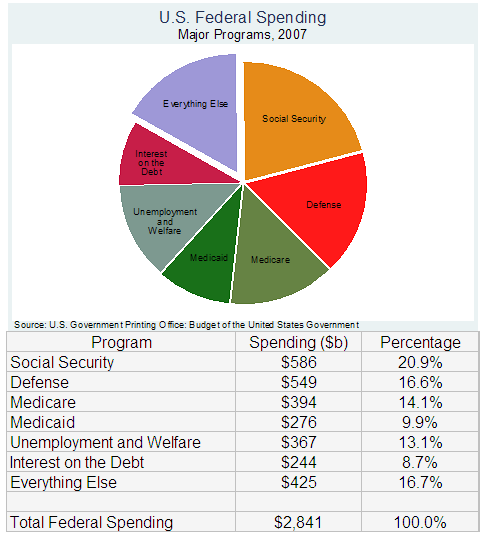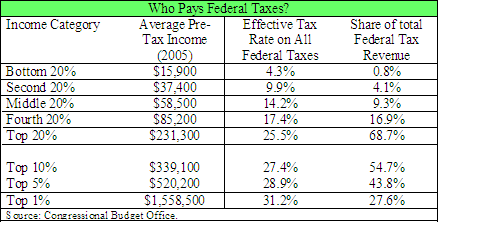
Economics, as a branch of the more general theory of human action, deals with all human action, i.e., with mans purposive aiming at the attainment of ends chosen, whatever these ends may be.--Ludwig von Mises
Sunday, December 30, 2007
Wednesday, December 26, 2007
Tax Law Changes Equals Increasing Paychecks
For a single person earning $50,000 per year (assume all wages/salaries and no adjustments), his federal individual income tax bill under 2007 tax parameters would be calculated as follows:
AGI = $50,000
Income Tax After Credits for 2007 tax law = $6,736.25
Now for a person earning $50,000 under the 2008 tax parameters:
AGI = $50,000
Income Tax After Credits for 2007 tax law = $6,606.25
The person would save $130 on the year assuming no pay change, which would be about a $5.42 pay increase per pay period (assuming two per month).
source: Tax FoundationIt is not much, but declining tax bills are good. Although I'm not holding my breath.
Sunday, December 23, 2007
Life After Peak Oil--Gregory Clark
Oil prices have receded from their recent flirtation with $100 a barrel, but demand soars from China and India, rapidly industrializing countries with a massive energy thirst. The combination of increased demand, high prices and the prospect of an eventual peak in oil production, has caught Americans paralyzed between twin terrors: the fear that rampant consumption of oil and coal is irreversibly warming the Earth and the dread that without cheap oil our affluent lifestyles will evaporate...
Study of the long economic history of the world suggests two things, however. Cheap fossil fuels actually explain little of how we got rich since the Industrial Revolution. And after an initial period of painful adaptation, we can live happily, opulently and indeed more healthily, in a world of permanent $100-a-barrel oil or even $500-a-barrel oil...
Many people think mistakenly that modern prosperity was founded on this fossil energy revolution, and that when the oil and coal is gone, it is back to the Stone Age. If we had no fossil energy, then we would be forced to rely on an essentially unlimited amount of solar power, available at five times current energy costs. With energy five times as expensive as at present we would take a substantial hit to incomes. Our living standard would decline by about 11 percent. But we would still be fantastically rich compared to the pre-industrial world...
At current rates of economic growth we would gain back the income losses from having to convert to solar power in less than six years. And then onward on our march to ever greater prosperity.
Gregory Clark is professor and chair of the Department of Economics at the University of California, Davis.
read the entire essay
Saturday, December 22, 2007
Class Information
Order of Chapters:
1st Semester: 1, 2,16,12, 3, 4, 5, 6, 7, 9
2nd Semester: 10,11, 14, 15, 18, Personal Finance
Etc.
This blog is a work in progress to help the class run more efficiently. Feel free to post comments about improving the blog. Remember, I am a technological illiterate...
Goal:
To provide on-line access to virtually all class information. With the ultimate goal of being "paperless".
Updated: 8/5/09
Personal Finance (Course Work)
Money 101--from CNN Money
23 basic lessons
Financial Literacy
11 areas of finance with articles, tools, and FAQs for each
Feed the Pig
Good info about savings
Kiplinger Money Basics
Wall Street Journal Personal Finance Guide
Sources of Capital (Chapter 9)
Study Guide
Chapter 9 study guide
Notes
Chapter 9 notes
Chapter 9 notes fill in
Activity
Handouts
Articles
Additional Readings
International Trade (Chapter 18)
Chapter 18 Study Guide
Notes
Chapter 18 notes
Chapter 18 notes fill in
Activity
Handouts
Articles
Additional Readings
Other Info
Developing Countries (Chapter 17)
"The problem of rendering the underdeveloped nations more prosperous cannot be solved by material aid. It is a spiritual and intellectual problem. Prosperity is not simply a matter of capital investment. It is an ideological issue. What the underdeveloped countries need first is the ideology of economic freedom and private enterprise." Ludwig von Mises: Money, Method, and the Market Process
Study Guide
Chapter 17 Study Guide
Notes
Chapter 17 notes
Chapter 17 notes fill in
Activity
Handouts
Articles
Additional Readings
Other Info
Fiscal Policy (Chapter 15)
Chapter 15 Study Guide
Notes
Chapter 15 notes
Chapter 15 notes fill in
Activity
Handouts
Articles
Additional Readings
Other INfo
The Federal Reserve and Monetary Policy (Chapter 14)
Chapter 14 Study Guide
Notes
Chapter 14 notes
Chapter 14 notes fill in
Activity
Handouts
Articles:
A Classic Hayekian Hangover Roger Garrison and Gene Callahan
Thinking Like a Center Banker by William Poole
Additional Readings
Other Info
Money and the Banking System (Chapter 13)
Chapter 13 Study Guide
Notes
Chapter 13 notes
Chapter 13 notes fill in
Activity
Handouts
Articles
Is the Gold Standard Still the Gold Standard among Monetary Systems? by Lawrence H. White
Additional Readings
Other Info
Role of Government (Chapter 12)
Study Guide
Chapter 12 Study Guide
Notes
Chapter 12 notes
Chapter 12 notes fill in
Activity
Handouts
Articles
Additional Readings
A World Without the FDA
Websites
FDA Review
Economic Challenges (Chapter 11)
Chapter 11 Study Guide
Notes
Chapter 11 notes
Chapter 11 notes fill in
Activity
Handouts
Articles
Additional Readings
Other Info
Economic Performance (Chapter 10)
Chapter 10 Study Guide
Notes
Chapter 10 notes
Chapter 10 notes fill in
Activity
Handouts
Articles
Additional Readings
Other
Business Organizations (Chapter 7)
Study Guide
Chapter 7 study guide
Notes
Chapter 7 notes
Chapter 7 notes fill in
Activity
Handouts
Articles
Additional Reading
Market Structures (Chapter 6)
Study Guide
Chapter 6 study guide
Notes
Chapter 6 notes
Chapter 6 notes fill in
Activity
Handouts
Articles
Additional Readings
Prices (Chapter 5)
Study Guide
Chapter 5 study guide
Notes
Chapter 5 notes
Chapter 5 notes fill in
Activity
Handouts
Articles
Additional Readings
Supply (Chapter 4)
Study Guide
Chapter 4 study guide
Notes
Chapter 4 notes
Chapter 4 notes fill in
Activity
Handouts
Articles
Additional Readings
Demand (Chapter 3)
Study Guide
Chapter 3 study guide
Notes
Chapter 3 notes
Chapter 3 notes fill in
Activity
Handouts
Articles
Additional Readings
Comparing Economic Systems (Chapter 16)
Chapter 16 Study Guide
Notes
Chapter 16 notes
Chapter 16 notes fill in
Activity
Handouts
Articles
Additional Readings
Other Info
Economic Systems (Chapter 2)
Study Guide
Chapter 2 Study Guide
Notes
Chapter 2 notes
Chapter 2 notes fill in
Activity
Handouts
Articles
Additional Readings
Tragedy of the Commons by Garrett Hardin
The Commons: Tragedy or Triumph?
Games
Tragedy of the Bunnies a game that illustrates the "tragedy of the commons"
What is Economics? (Chapter 1)
Study Guide
Chapter 1 Study Guide
Notes
Chapter 1 Notes
Chapter 1 Notes Fill In
Activity
Why Are We a Nation of Couch Potatoes?
Handouts
Economics in One Page
Articles
Opportunities and Costs
Opportunities and Costs questions
Additional Readings
I, Pencil
Largest Wall Street Bonus Ever
Blankfein was awarded $26.8 million in cash and $41.1 million in restricted stock and stock options, according to a company filing with the Securities and Exchange Commission issued Friday.
With this year's bonus, Blankfein shatters the record he set a year ago, when he was awarded $54 million.
Friday, December 21, 2007
Thursday, December 20, 2007
New Corvette

"High-performance cars like this may be legislated out of existence," Corvette chief engineer Tadge Juechter said...
GM will likely build about 2,000 ZR1s annually in an effort to maintain exclusivity. Besides the ZR1, which goes on sale later in 2008, Chevrolet sells other versions of the car for base prices between $46,000 and $71,000.
Wednesday, December 19, 2007
Google Challenges Wikipedia
Google, Inc. announced Thursday that it is working on a collaborative online encyclopedia that could compete with Wikipedia, the popular user-edited encyclopedia.
The "knol" project – named for Google's shorthand for a unit of knowledge – will allow a user to create an entry on virtually any topic. Like Wikipedia, it will allow anyone to add an entry, but unlike the largely anonymous Wikipedia, it will post an author's byline and profile with each entry.
read the articlePersonal FInance: Investing Advice
The new book Jim Cramer's Stay Mad for Life is a primer for saving and investing. It advises readers to pay off credit cards, make the most of 401(k) plans and individual retirement accounts (IRAs), and get the right kinds of insurance. The subtitle of the book, written with Cliff Mason: Get Rich, Stay Rich (Make Your Kids Even Richer).
Most people actually won't get rich by buying individual stocks, Cramer says. Unless you do your homework, namely spending an hour a week researching for each stock you own, "You won't beat the market, and you'll probably lose money," he writes.
For Cramerites willing to do the research, the book helps construct a long-term, diversified portfolio. For most people, however, he advises low-fee stock index funds.
All the personal finance advice you ever need in 3 paragraphs. A couple of other points, spend less than you make. Don't get an adjustable rate mortgage.
Wealhiest Americans

Standard of Living for wealthy Americans.
New book:
All the Money in the World: How the Forbes 400 Make--and Spend--Their Fortunes
more charts here
Tuesday, December 18, 2007
Austrian-style Business Cycle
Though deficient in the powers of foresight and observation, economists do believe they know how to treat an economy on the brink of recession, as this one seems to be. They administer what non-economists know as the “hair of the dog that bit you.”
But booms not only precede busts, they also cause them. Bargain-basement interest rates are a potent stimulant. Borrowing more than they might at higher rates, people stretch. Businesses stock up on labor, machinery and buildings. Consumers buy cars and houses — houses, especially, these past five years. The G.D.P. takes flight.
Then unwelcome facts intrude. Easy money, it seems, was an illusion. Society was not so rich as it seemed. The prosperous future for which people had collectively prepared is slow to arrive. The inflation rate picks up. Supposedly creditworthy consumers and businesses turn out to be risky. They were creditworthy only so long as lenders were willing to advance them more and more funds at those ever-so-affordable low rates.
Now what to do? Why, slash interest rates to coax forth still more lending and borrowing. It’s the customary curative, seemingly as humane as it is politic.
And if recessions served no useful purpose, it might be. But recessions do. On Wall Street, they speak of “corrections.” What corrections correct are errors in judgment. So do recessions.
They allow the sorting out of boomtime error. They permit — indeed, force — the repricing of inflated assets. In a downturn, previously overpriced businesses, houses and buildings are made affordable again.
Naturally, people hate these painful, salutary interludes. Nobody likes insecurity, bankruptcy and joblessness. So the Fed keeps slashing interest rates. And this balm does mitigate the suffering. Homeowners and businesses refinance their debts. Fewer houses are thrown on an overstocked market.
Observe, however, that the great preceding illusion is undispelled. Prices have not come down as they should have. Neither has indebtedness. The architecture of the economy remains as it was. Land, labor and capital are still structured for an imagined glittering future.
Presently, a new upcycle does begin, but it’s slow off the mark. The world’s top economy seems curiously sluggish. And the economists and politicians ask, “What happened to America’s dynamic economy?” The answer: It’s wrapped in the coils of debt.
— James Grant, the editor of Grant’s Interest Rate Observer.
HT: Mises Blog
Monday, December 17, 2007
The Rich Are Paying Taxes
Recession in 2008?
 In the latest WSJ.com survey of economists, forecasters on average put the chance of a recession -- often defined as two straight quarterly declines in gross domestic product -- at 38%. That's the highest in more than three years, but the forecasters' best bet right now is that the U.S. will skirt a recession...
In the latest WSJ.com survey of economists, forecasters on average put the chance of a recession -- often defined as two straight quarterly declines in gross domestic product -- at 38%. That's the highest in more than three years, but the forecasters' best bet right now is that the U.S. will skirt a recession...read the WSJ article
Saturday, December 15, 2007
Friday, December 14, 2007
Parents: Questions, Comments, and Suggestions
Students: Questions, Comments, and Suggestions
The end is near.
Thursday, December 13, 2007
Producer Price Index up 3.2%
Wednesday, December 12, 2007
Saturday, December 8, 2007
Friday, December 7, 2007
Students: Questions, Comments, and Suggestions
Parents: Questions, Comments, and Suggestions
Thursday, December 6, 2007
Where Would You Prefer to Live?

House B

One house has hot and cold running water, central air conditioning, electricity and flush toilets. The other does not. One owner has a a computer, a high speed connection to the Internet, a DVD player with a movie collection, and several television sets. The other has none of these things. One owner has a refrigerator, a vacuum cleaner, a toaster oven, an iPod, an alarm clock that plays music in the morning, a coffee maker, and a decent car. The other has none of these. One owner has ice cubes for his lemonade, while the other has to drink his warm in the summer time. One owner can pick up the telephone and do business with anyone in the world, while the other had to travel by train and ship for days (or weeks) to conduct business in real time.
from Coyote Blog
Wednesday, December 5, 2007
Tuesday, December 4, 2007
National Debt: $9.13 trillion

That's $10,000,000,000,000.00, or one digit more than an odometer-style "national debt clock" near New York's Times Square can handle. When the privately owned automated clock was activated in 1989, the national debt was $2.7 trillion.
read the article

























